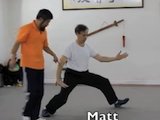In today’s class, the following students received partial form corrections. Form corrections are always foundational.
- Jacek Wolochowski
- Jody Hall
- Yuxin Liu
- Kevin Chen
- Lutz Liese
- Pawel Muller
- Sevastianos Maillis
- Felicia Fong
- Travis Knaub
- Paul Pryce
- Simon Yau
Jacek Wolochowski
- In with elbow, out with hand.
- When you don’t move your hand, it forces you to move your elbow, shoulder and waist.
Jody Hall
- Hand and elbow relationship is not there. We need a twist there.
- Partner Exercise: Partner holds onto your hand to ensure it does not move. Twist the elbow in. Do this for three months every day.
- This move is called to pull in is to push out. To withdraw is to issue.
- When you achieve this, is called Peng. Example: When you hit a drum and the two ends stretch the equalise the movement.
Yuxin Liu
- Cloud Hands. Number two needs to be clearer. The stretch must be very large.
- The eyes and knee must not move.
Kevin Chen
- Example: Opening a bottle by holding the cap and twisting the bottom. Or the reverse.
- Cloud Hands. Dantian and two knees lock, only rotate the top.
- Example with a piece of paper. Lock the front kua and only stretch the rear kua.
Lutz Liese
- Moves are not deep enough.
- Your moves have to reach the four corners.
- The outside size is when you set a limit, you have to reach it. Inside means you also have to reach it.
Pawel Muller
- Create a feeling that you are breaking out of something, yanking something, breaking something. You need to do damage.
Sevastianos Maillis
- Put some real effort and use power. The indication is sweat.
Felicia Fong
- Keep the back straight.
Barb Steger
- In with elbow, make your body very small. Out with hand, make the body very large.
Travis Knaub
- Do the form with a very low stance. Directions are 45 degrees and straight.
Paul Pryce
- Shoulders and kua are not wide open enough.
- Exercise: Use two hands to hold onto a bar and stretch the shoulders and kua.
Simon Yau
- We have to learn with a method. And see what move causes what. When you look at people we should be able to see what they are trying to do.
Don’t ask questions / But we need to ask questions!
- Question, assertion, discussion. We confuse these three, because they are similar.
- What is a question? It is to lead the teacher to the topic and to ask what to do and to demonstrate.
- Example, I don’t know what to do with my baihui, what do I do?
- When we have a question and say, is it this or that, we have already made an assertion. When we make the assertion, we are limiting the answer to a box constrained by what we already know. The answer is often outside of the box.
- Hong’s teaching method. Never listen to students descriptions. Only show what is correct.
Q&A Relating to baihui vertical line
- Everything has two actions to it. First is never right or wrong. It sets the point of reference. The second action.
- Example: Take a rubber cord with two ends (A) and (B). Where you place (A) is not important. Once you place it, it becomes a point of reference. This is the first action. The second action is to stretch (B) away from (A).
Cloud hands. The kua acts as a telescopic rod.


